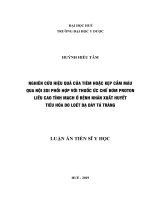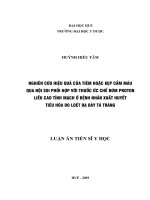nghiên cứu hiệu quả của tiêm và kẹp cầm máu qua nội soi phối hợp với thuốc ức chế bơm proton ở bệnh nhân xuất huyết tiêu hoá do loét dạ dày tá tràng
Bạn đang xem bản rút gọn của tài liệu. Xem và tải ngay bản đầy đủ của tài liệu tại đây (433.96 KB, 6 trang )
<span class='text_page_counter'>(1)</span><div class='page_container' data-page=1>
<b>TRÍCH YẾU LUẬN ÁN </b>
<b>1. Họ và tên nghiên cứu sinh: HUỲNH HIẾU TÂM </b>
<i><b>2. Tên luận án: “Nghiên cứu hiệu quả của tiêm và kẹp cầm máu qua nội </b></i>
<i><b>soi phối hợp với thuốc ức chế bơm proton ở bệnh nhân xuất huyết tiêu hoá do </b></i>
<i><b>loét dạ dày tá tràng” </b></i>
<b>3. Chuyên ngành: Nội Tiêu hoá </b>
<b>4. Mã số: 62.72.01.43 </b>
<b>5. Người hướng dẫn khoa học: </b>
<b>GS.TS. Hoàng Trọng Thảng - Trường Đại học Y Dược Huế </b>
<b>TS. Hồ Đăng Quý Dũng </b> <b>- Bệnh viện Chợ Rẫy </b>
<b>6. Cơ sở đào tạo: Trường Đại học Y Dược Huế- Đại học Huế </b>
<b>7. Mục đích và đối tượng nghiên cứu </b>
Xuất huyết tiêu hóa do loét dạ dày tá tràng là bệnh cấp cứu nội và ngoại
khoa, chiếm tỷ lệ khoảng 50% trong tất cả các nguyên nhân gây xuất huyết tiêu
hóa trên, với tỷ lệ tử vong từ 6-13%. Nội soi điều trị bệnh lý xuất huyết tiêu hóa
do loét dạ dày tá tràng ngày càng phát triển với nhiều phương pháp như tiêm cầm
máu, đốt điện cầm máu, kẹp cầm máu và gần đây là phương pháp cầm máu bằng
phun chất bột (Hemospray). Ở nước ta, chủ yếu vẫn sử dụng phương pháp tiêm
cầm máu đơn độc, chỉ có một số ít bệnh viện tuyến tỉnh áp dụng thêm phương
pháp kẹp cầm máu.
<b>Mục tiêu nghiên cứu </b>
1. So sánh hiệu quả cầm máu của hai phương pháp tiêm HSE hoặc kẹp cầm
máu phối hợp với thuốc ức chế bơm proton liều cao tĩnh mạch ở bệnh nhân xuất
huyết tiêu hóa do loét dạ dày tá tràng.
2. Khảo sát một số yếu tố liên quan đến sự thành công của hai phương pháp tiêm
HSE hoặc kẹp cầm máu phối hợp với thuốc ức chế bơm proton liều cao tĩnh mạch.
<b>Đối tượng nghiên cứu </b>
</div>
<span class='text_page_counter'>(2)</span><div class='page_container' data-page=2>
<b>8. Phương pháp nghiên cứu </b>
Nghiên cứu tiến cứu có can thiệp điều trị. Theo dõi dọc với hai nhóm song
song, theo dõi các mục tiêu từ lúc bệnh nhân nhập viện đến khi ra viện hoặc đến
khi phẫu thuật hay tử vong.
<b>9. Các kết quả chính </b>
<i><b>9.1. Hiệu quả cầm máu ban đầu </b></i>
Hiệu quả cầm máu ban đầu thành công của hai nhóm nghiên cứu tiêm HSE
và kẹp cầm máu rất cao 97,4% và 97,2%, tỷ lệ cầm máu ban đầu thất bại rất thấp
2,6% và 2,8%.
<i><b>9.2. Xuất huyết tái phát </b></i>
Nhóm tiêm HSE và nhóm kẹp cầm máu có tỷ lệ xuất huyết tái phát là
13,2% và 11,1%.
Trong nhóm đang chảy máu, tỷ lệ xuất huyết tái phát ở nhóm đang chảy gần
tương đương nhau 18,7% ở nhóm tiêm HSE và 17,6% ở nhóm kẹp cầm máu.
Trong nhóm có mạch máu lộ, tỷ lệ xuất huyết tái phát là 9,1% ở nhóm tiêm
HSE và 5,3% ở nhóm kẹp clip cầm máu.
Trong nhóm bệnh nhân có choáng, tỷ lệ xuất huyết tái phát là 0% ở nhóm
tiêm HSE và 12,5% ở nhóm kẹp clip cầm máu.
<i><b>9.3. Một số yếu tố ảnh hưởng đến kết quả điều trị thành công của hai </b></i>
<i><b>phương pháp cầm máu </b></i>
Các yếu tố như tuổi, có bệnh lý phối hợp, tình trạng chống, tổn thương theo
phân loại Forrest, chưa thấy có dự khác biệt ảnh hưởng đến sự thành công của hai
phương pháp điều trị.
Kích thước ổ lt to có sự khác biệt về tỷ lệ thành công giữa hai phương
pháp điều trị, 25% ở nhóm tiêm HSE thành cơng và 3,2% ở nhóm kẹp cầm máu
thành cơng với p=0,035.
<b>10. Kết luận </b>
</div>
<span class='text_page_counter'>(3)</span><div class='page_container' data-page=3>
phương pháp tiêm HSE và kẹp cầm máu. Phổ biến rộng rãi phương pháp cầm
máu bằng tiêm dung dịch HSE, kẹp clip cầm máu qua nội soi ở bệnh nhân xuất
huyết tiêu hóa do loét dạ dày tá tràng cho các cơ sở y tế tuyến huyện ở đồng
bằng sông Cửu Long.
<b>Người hướng dẫn </b>
<b>TS. Hồ Đăng Quý Dũng</b>
<i>Huế, ngày 09 tháng 08 năm 2018 </i>
<b>Nghiên cứu sinh </b>
</div>
<span class='text_page_counter'>(4)</span><div class='page_container' data-page=4>
<b>ABSTRACT </b>
<b>1. PhD Candidate: HUYNH HIEU TAM </b>
<i><b>2. Dissertation tile: “Research of the efficacy of endoscopic hemostatic </b></i>
<i><b>injection or hemoclip combined with intravenous high-dose pomp proton </b></i>
<i><b>inhibitors in patients with peptic ulcer bleeding”. </b></i>
<b>3. Speciality: Gastroenterology </b>
<b>4. Code: 62 72 43 </b>
<b>5. Full names of advisors: </b>
<b>Prof. Dr. Hoang Trong Thang - Hue University of Medicine and Pharmacy </b>
<b>Dr. Ho Dang Quy Dung </b> - Cho Ray Hospital
<b>6. Name of training institude: Hue University of Medicine and Pharmacy- </b>
Hue University.
<b>7. Research objectives and subjects </b>
Gastrointestinal bleeding from peptic ulcer is a medical and surgical
emergency, accounts for about 50% of all causes of upper gastrointestinal
bleeding, with a mortality rate of 6-13%. Endoscopic treatment of gastrointestinal
bleeding due to peptic ulcer is rapidly developing with many methods such as
hemostatic injection, haemostatic thermal probe, hemoclip and recently spraying
powder (Hemospray). In our country, mainly using the method of hemostatic
injection alone, only a small number of provincial hospitals apply additional
<b>hemostatic hemoclip method. </b>
<b>Obsjectives </b>
1. To compare the efficacy of endoscopic hemostatic injection or hemoclip
combined with intravenous high-dose pomp proton inhibitors in patients with
peptic ulcer bleeding.
</div>
<span class='text_page_counter'>(5)</span><div class='page_container' data-page=5>
<b>Subsjects </b>
The study was conducted at Can Tho Central General Hospital from May
2012 to November 2014. The subject were divided into two groups: 38 patients
were treated with HSE injection and 36 patients received hemoclip.
<b>8. Research method </b>
Prospective study intervention. Vertical monitoring with two parallel
groups, monitoring of goals from patient admission to hospital discharge or
surgery or death.
<b>9. Main research outcomes </b>
<i><b>9.1. The initial bleeding efficacy </b></i>
The initial bleeding efficacy of the two hemostatic groups was very high at
97.4% in HSE injection and 97.2% in hemoclip, the initial hemostatic rate failure
was very low at 2.6% in HSE injection and 2.8% in hemoclip.
<i><b>9.2. The recurrent bleeding </b></i>
The HSE injection group and the hemoclip group had recurrent bleeding
rates of 13.2% and 11.1%.
In the active bleeding group, recurrent bleeding rates were approximately
18.7% in the HSE injection group and 17.6% in the hemoclip group.
In the visible vessel group, recurrent bleeding rates were approximately
9.1% in the HSE injection group and 5.3% in the hemoclip group.
In shock patients, recurrent bleeding rates were approximately 0% in the
HSE injection group and 12.5% in the hemoclip group.
<i><b>9.3. Some factors affect the successful outcome of the two hemostatic methods </b></i>
Factors such as age, co-morbidities, shock and the Forrest classification
have not yet been found to have a significant difference on the success of the
two treatments.
</div>
<span class='text_page_counter'>(6)</span><div class='page_container' data-page=6>
<b>10. Conclusion </b>
The dissertation is of scientific value and has practical significance. The
results of this study may supplement data on hemostatic efficacy and early
recurrent hemorrhage rates of both HSE injection and hemoclip methods.
Widespread dissemination of haemostasis with HSE injection therapy, hemoclip
in endoscopic hemostasis in patients with gastrointestinal bleeding from peptic
ulcer disease for district health services in the Mekong Delta.
<b>Advisor</b>
<b>Dr. Ho Dang Quy Dung</b>
<i>Hue, August 09, 2018 </i>
<b>Doctoral candidate </b>
</div>
<!--links-->









